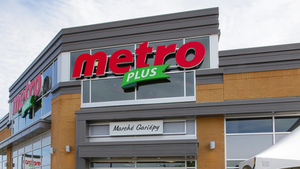J. SAINSBURY TO HIKE U.S. SHARE; WON'T SELL SHAW'S
LONDON (FNS) -- J. Sainsbury plc here is sticking with the United States and plans to increase its market share.There have been reports for the last several months that Sainsbury, the United Kingdom's second-largest food retailer, might sell Shaw's Supermarkets, East Bridgewater, Mass., which has performed poorly over the last 18 months following a move into Connecticut. The reports were stirred by
November 2, 1998
JAMES FALLON
LONDON (FNS) -- J. Sainsbury plc here is sticking with the United States and plans to increase its market share.
There have been reports for the last several months that Sainsbury, the United Kingdom's second-largest food retailer, might sell Shaw's Supermarkets, East Bridgewater, Mass., which has performed poorly over the last 18 months following a move into Connecticut. The reports were stirred by Sainsbury's decision to sell its 20% holding in Giant Food, Landover, Md., to Ahold of Zaandam, Netherlands.
That deal was completed last week, with Sainsbury realizing pretax profits of about $160 million on the deal.
But Dino Adriano, Sainsbury's chief executive, said the British company had no intention of selling Shaw's and may even consider transferring other formats to the United States. "We remain committed to Shaw's and believe that the U.S. market continues to offer Sainsbury's value-generating opportunities," he said.
Sainsbury continues to believe the consolidation of the U.S. food-retailing market will take at least seven years and that at the end of that period "annual sales of $10 billion, backed up with a No. 1 or a strong No. 2 position in a definable regional market, will become the threshold for delivering sustained growth at the end of the cycle," Adriano said.
This is despite the recent megamerger of Albertson's and American Stores Co., the Kroger Co. buyout of Fred Meyer Inc., and the news that Wal-Mart is rolling out its Neighborhood stores format.
"We don't have to be the same scale as a Wal-Mart," said David Bremner, the Sainsbury's director responsible for North America.
"We believe $10 billion is sufficient to generate the returns we need to succeed in the U.S. as a global retailer."
Bremner pointed out that all the mergers and acquisitions in recent months in the United States have involved publicly owned companies.
"Half the market is still unconsolidated and the majority of those companies are privately owned," he said. "So there's still sufficient room and time to get bigger in the U.S., which is our plan subject to improving shareholder value."
Those last words are key when it comes to Sainsbury and the United States. The company has scaled back its originally ambitious plans in the United States and now says it doesn't plan further organic growth outside its existing territories of Connecticut, Massachusetts, Rhode Island, Vermont, New Hampshire and Maine. Its decision to sell its Giant shares is an indication of this new philosophy.
However, Sainsbury sees plenty of opportunity to expand Shaw's in its existing markets, both with new stores, larger replacement stores and by expanding existing units. Shaw's currently has 124 stores and Sainsbury's plans to open two stores and remodel three more in the second half. It also plans to close three stores.
The expansions are aimed at increasing the Shaw's stores to about 35,000 to 45,000 square feet from their current 25,000 to 35,000. Shaw's also will continue to open its superstore format of about 65,000 to 75,000 square feet. The difference between the stores is primarily the cutting out in the smaller units of the large takeout food department, Sainsbury executives said.
The company also sees potential to transfer other formats to the United States, especially the convenience-store format it's currently testing at two locations in the United Kingdom. "We could see that working very well in certain locations in the U.S.," Bremner said.
The United Kingdom's second-largest food retailer last week revealed its subsidiary Shaw's Supermarkets had a 25.3% increase in operating profit to $46 million on a 9.3% rise in sales to $1.63 billion for the half-year ended Sept. 19.
This compares with operating profit of $36.7 million on sales of $1.49 billion in the corresponding period a year earlier.
Sainsbury reported an 18.8% rise in group after-tax profit to $527.7 million (316 million pounds) from $444.2 million, on a 5.9% increase in sales to $14.47 billion from $13.66 billion, for the 28 weeks ended Sept. 29.
Meanwhile, it was reported last week that Lord Sainsbury of Drury Lane, whose marketing and merchandising skills sparked Sainsbury's sharp growth in the United Kingdom earlier in this century, died at the age of 96. Sainsbury, who was active in the company for over five decades, was made a life president upon his retirement in 1967. He brought the self-service concept to the family-run chain in the 1950s. He was a member of Britain's House of Lords and active in politics for much of his long life.
About the Author
You May Also Like




